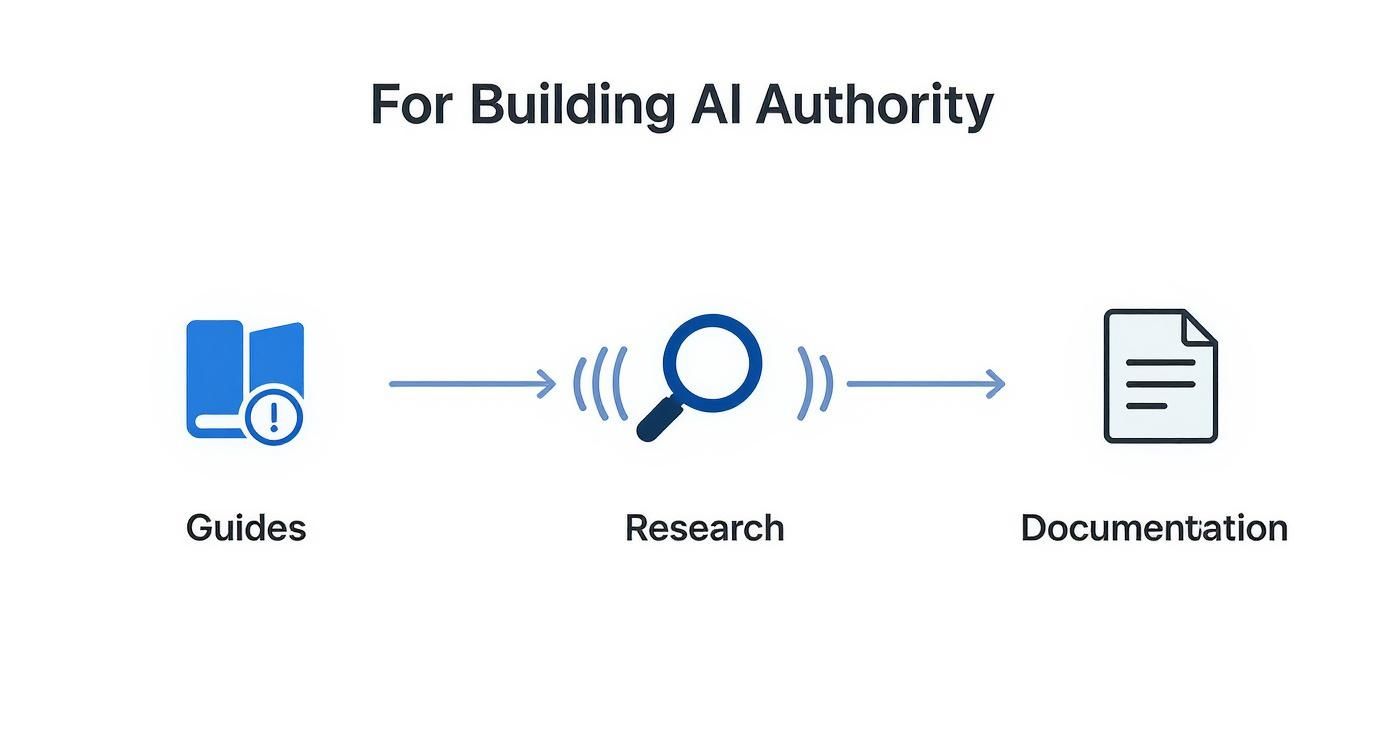Ranking in ChatGPT isn't like old-school SEO. It’s about becoming such a trusted, authoritative source that an AI chooses to cite you.
This new game is called Generative Engine Optimization (GEO), and it's a completely different way of thinking. You're no longer just trying to match keywords; you're building brand authority, creating content for real human questions, and making sure your information is easy for AI models to digest.
The New Rules of Generative Engine Optimization
Welcome to the new frontier. If you’re still focused on gaming algorithms with backlinks and keyword density, you’re already behind. To get noticed by ChatGPT, you have to become a primary, trusted source for the AI itself.
This requires a fundamental shift in mindset. We're moving from a world of targeting keywords to a world of establishing deep, conversational relevance.
It's not just a rebrand of SEO; it’s a whole new playbook. We're now in the era of Generative Engine Optimization (GEO), where the goal isn't just to be clicked—it's to be cited.
Think of it this way: traditional SEO is like trying to get your flyer noticed on a crowded bulletin board. GEO is like becoming the go-to expert that everyone in town recommends by name.
From Keywords to Authority
At its core, GEO is all about making your own domain the most powerful asset for AI visibility. Models like ChatGPT don't crawl the web like Googlebot. Instead, they learn from a massive dataset of web pages, forums, and reviews to figure out who the real authorities are.

To win here, your strategy has to evolve. You need to zero in on what the AI values:
- Building Branded Domain Authority: This means positioning your website as the definitive source of truth in your niche. Period.
- Answering Conversational Queries: You have to structure your content to directly answer the detailed, natural-language questions people are actually asking AI assistants.
- Leveraging Community Signals: Discussions on platforms like Reddit aren't just chatter; they're critical training data for AI models. What people say there matters.
This isn't optional anymore, especially when you consider the sheer scale of AI's influence. ChatGPT pulls in around 5.24 billion visits each month, making it a giant in how information is discovered and shared.
As the fifth most visited website globally, its impact on brand discovery is impossible to ignore. For a deeper look into this evolving field, check out our complete guide on AI search engine optimization.
Build Authority That AI Trusts
To show up consistently in ChatGPT, you can't just be a result on a page. You need to become the definitive, trusted source for your niche.
This is all about building what I call branded domain authority. It's easily the single most important factor in what we're now calling Generative Engine Optimization (GEO).
The goal is to teach the AI that whenever a user asks about your industry, your product, or a problem you solve, your domain is the most reliable place to find the answer. This requires moving beyond standard blog content and creating foundational assets that lock in your authority.
Creating Foundational Content Assets
To build this kind of trust with an AI, your content strategy has to prioritize depth and originality. Generic, rehashed blog posts just won't cut it anymore. You need to focus on creating high-value, irreplaceable content that can't be found anywhere else.
So, what does this actually look like?
- In-Depth Product Guides: I'm not talking about a simple feature list. Create massive guides covering every single aspect of your product—use cases, troubleshooting, advanced tips, and integrations. Stuff that only you can provide.
- Original Research and Reports: Run your own studies. Conduct industry surveys. Analyze your internal data. When you publish unique findings and proprietary data, you instantly become a primary source that others—including the AI—will have to cite.
- Comprehensive Documentation: Never underestimate your help docs, API documentation, and technical whitepapers. This content is a goldmine for AI. It's structured, factual, and directly answers specific, high-intent questions, making it perfect training material.
This strategy works because AI models are designed to find and prioritize the most credible information. In fact, a recent analysis showed that ChatGPT has a huge preference for citing branded vendor websites directly.
They have a +11.1 points citation advantage over what you might see on Google. That means the AI already sees your own site as more authoritative by default.
Your own domain isn't just a marketing channel anymore. It's now a primary source of training data for the world's most powerful AI models. Treat every single piece of content you publish as a chance to teach the AI that you are the expert.
Before you start building out new content, it's a good idea to see how your different types of content are perceived by different search systems.
Branded vs Third-Party Content Authority
Here’s a quick breakdown of how ChatGPT and Google tend to view content authority from different sources. You'll notice they have very different priorities.
As you can see, ChatGPT puts a massive premium on content that comes directly from the source—your brand. It sees your documentation and proprietary data as ground truth. Google, on the other hand, still gives a lot of weight to third-party signals like reviews and backlinks to general blog content. This shift is exactly why your content strategy needs to adapt.
Conducting an Authority Content Audit
Before you create anything new, figure out your biggest opportunities by auditing what you already have. This process helps you spot gaps and find places where you can strengthen your authority signals. A solid online reputation is the foundation for all of this, so your audit needs to assess how your content contributes to it. If you need a framework, our online reputation management guide can help you structure the process.
Start by asking a few simple questions:
- Does our content answer questions definitively? Look at your top-performing pages. Do they provide a complete answer, or do they leave the user hanging and needing to search again?
- Is our information proprietary? How much of your content is based on your own unique data, your team's experience, or a perspective that no one else has? Be honest.
- Where are we the sole source of truth? Pinpoint the topics where your company is the undisputed expert. Think about your product features, your company history, or your own customer case studies. Double down on those areas.
By focusing on these foundational assets and continuously auditing your content for authority, you're not just publishing articles—you're actively training AI models to see your domain as the primary source of truth.
Map Your Content to Conversational Queries
Let's get one thing straight: people don't talk to ChatGPT the way they talk to Google. The era of typing fragmented keywords like "project tool gantt chart" is over. We’ve moved on.
Instead, users are asking detailed, conversational questions. Think, "Which project management tool is best for a remote team that needs Gantt charts and Slack integration?"
This isn't just a small shift—it demands a whole new way of thinking about content. Your job is no longer to just match keywords. It's to directly answer the nuanced, complex questions your audience is asking AI. You have to get inside their heads, understand the specific problems they're trying to solve, and map your content directly to those conversational prompts.
Uncovering Conversational Intent
So, where do you start? Traditional keyword research tools still have their place, but you need to go a layer deeper. Think about the full questions that your keywords are just a shorthand for.
Take a broad term like "SaaS marketing." Instead of just targeting that phrase, think about the real, practical questions a marketer is wrestling with:
- "What are some low-cost marketing strategies for a new B2B SaaS product?"
- "How can I prove ROI from my content marketing efforts to my CEO?"
- "Which analytics platform is best for tracking user engagement in a SaaS app?"
These are the queries you need to be building your content around. To really nail this, you need a solid grasp of prompt engineering, which is all about how AI interprets and responds to user input. When you answer these specific questions directly, your site becomes an irresistible source for AI models looking for clear, authoritative answers.
This infographic breaks down a simple process for building the kind of authority that AI is designed to trust and cite.

It's a flow that makes perfect sense. You start with foundational guides, then publish unique research and technical docs. Each layer builds on the last, creating the kind of deep trust that AI models are built to recognize.
Weaving Answers into Your Content
Once you have a list of these conversational queries, the next step is to weave the answers naturally throughout your website. And I don't mean just slapping up an FAQ page and calling it a day. That's lazy.
This is about integrating a Q&A format into your entire digital presence.
Your product pages, guides, and even your "About Us" section should be structured to answer the questions your audience is asking. Every piece of content is an opportunity to provide a clear, direct answer that ChatGPT can easily parse and reference.
Let’s use a product page for a project management tool as an example. Instead of a dense wall of text listing features, break it down with subheadings that mirror real user questions:
- How does this tool handle recurring tasks?
- Can I integrate it with my existing calendar app?
- What kind of reporting dashboards are available?
By structuring your content this way, you're doing two things at once. You're making it incredibly scannable for human visitors, and you're making it dead simple for AI to understand. You're not just describing your product anymore; you're proactively answering the exact questions that lead people to buy.
This makes your site a go-to source for anyone looking for solutions, and it’s a non-negotiable step if you want to learn how to rank in ChatGPT.
Use Forums to Train the AI
Think of places like Reddit and Quora as more than just discussion boards. They're actually massive training grounds for large language models. Every conversation, every upvoted recommendation, and every solved problem teaches AI what real people think about different brands and solutions.
This isn't about spamming links. It's about strategically participating in conversations to shape how AI understands your brand.
When you consistently show up with genuinely helpful answers, you're feeding the AI a steady stream of positive data points associated with your brand. That's a powerful way to influence how to rank in ChatGPT.
Find Your Audience's Water Cooler
First things first, you need to find out where your audience is already hanging out and talking. Your job is to pinpoint the exact subreddits, Quora spaces, and niche forums where your potential customers are venting their frustrations and looking for answers.
Don't just stick to the obvious keywords. If you sell project management software, looking at r/projectmanagement is a good start, but the real gold is often found elsewhere. Your users are probably also active in:
- Industry-specific subreddits: Think
r/marketingorr/webdev, where professionals are constantly talking about the tools that make their jobs easier. - Problem-focused communities: Look for threads where people ask things like, "How do you manage a remote team's workload?"
- Competitor-related discussions: Find conversations where users are comparing alternatives or complaining about the limitations of another tool.
Pull together a focused list of 10-15 high-potential communities to monitor. It's way more effective than trying to be everywhere at once.
Remember, every helpful comment you leave is a data point for the AI. A well-upvoted, authentic answer in a relevant thread teaches the model that your brand is a credible solution to a specific problem.
Write Responses That Build Trust
Once you've found the right conversations, your approach is everything. This is where most brands stumble—they charge in with a sales pitch and get downvoted into oblivion. You have to provide real value first.
A great response doesn't feel like a promotion at all. For instance, if someone asks for advice on improving team collaboration, a solid reply would look something like this:
- Acknowledge and Validate: Start by showing you get it. "That's a tough challenge, especially with a distributed team." This immediately builds rapport.
- Offer Actionable Advice: Give them a few general tips or a simple framework they can use right away, no matter what tool they end up choosing. This establishes you as a helpful expert.
- Introduce Your Solution Casually: Only after you've provided genuine value should you bring up your product. Frame it as just one option that happens to solve the exact problem you just discussed. For example, "We actually built our tool to solve this exact issue by focusing on X and Y."
This method feels helpful, not promotional. It makes your brand part of the solution, not just more noise. To really nail this, you should adopt proven community engagement best practices that are all about authenticity.
By consistently contributing valuable insights, you create thousands of positive brand mentions across the web. These are the digital breadcrumbs that teach AI models to associate your name with expertise and recommend you in future responses.
Structure Your Content for AI Readability
It’s easy to forget that AI models don’t “read” content the way we do. They aren’t scanning for prose; they’re parsing for patterns, structure, and meaning. This means the way you format your content is just as important as the words you use. If you want to understand how to rank in ChatGPT, you have to make your content incredibly easy for an AI to deconstruct.

This starts with ditching the old wall-of-text format for good. Clear headings, short paragraphs, and strategic lists are no longer just good for user experience—they’re non-negotiable for AI consumption. Think of it as creating a clean blueprint that an AI can follow to grasp your main points instantly.
Break It Down for the Bots
The single most effective way to optimize for AI readability is to use a clear hierarchical structure. AI models lean heavily on HTML tags like H2s and H3s to figure out the relationships between different pieces of information on a page. When you use these tags correctly, you’re basically handing the AI a table of contents.
Your content should be organized with:
- A single, clear H1 title: This is the undisputed main topic of your page.
- Logical H2 subheadings: These break down the core topic into key sections.
- Specific H3 subheadings: These dive deeper, dividing your H2 sections into granular points.
This nested structure helps models like ChatGPT quickly identify the most important concepts and how they all connect. On top of that, keeping paragraphs to a maximum of 1-3 sentences makes each point distinct and easily digestible for both humans and machines.
Think of your content structure like a well-organized filing cabinet. Each heading is a labeled drawer, and each short paragraph is a neatly filed document inside. An AI can quickly find the exact piece of information it needs without having to rummage through a messy pile.
While humans and AI both appreciate clear formatting, their priorities differ slightly. Here’s a quick breakdown of what matters most to each.
Content Formatting for AI vs Human Readers
As you can see, elements like schema markup are almost exclusively for machines, while visual cues like bolding are more for human eyes. But the sweet spot—headings, short paragraphs, and lists—serves both beautifully.
The Superpower of Structured Data
Beyond just the visual layout, you can give AI an even clearer roadmap using schema markup. This is a form of structured data you add to your website's code to explicitly tell search engines and AI what your content is about. It’s like adding descriptive labels to your content that machines can read perfectly.
Implementing schema helps AI understand the context and relationships within your content. For example, you can use it to define:
- An "Article" with its author and publication date.
- A "Product" with its price, reviews, and unique features.
- An "FAQPage" with distinct questions and their corresponding answers.
This level of clarity is a superpower in the world of Generative Engine Optimization. When ChatGPT encounters a page with well-implemented schema, it doesn't have to guess the meaning or context of your information. You’ve already done the hard work for it, making your content a highly reliable and citable source.
Measure Success in the New Age of Search
Traditional rank trackers are quickly becoming relics. In the world of generative AI, you can’t just check your keyword position on Google and call it a day. Measuring success demands a totally new mindset and a different set of tools.
The game has shifted. The new metrics revolve around your brand’s influence inside AI-generated answers. This means you need practical, consistent methods for tracking when and how your brand gets mentioned, because visibility at the point of recommendation is all that matters now.
Tracking Brand Mentions and Citations
The most direct way to measure your impact is to monitor for brand mentions and direct citations of your domain in ChatGPT’s responses. But this isn't a one-and-done check. It requires a systematic approach to see how your visibility ebbs and flows over time.
You can do this manually or start using the emerging AI search visibility tools designed for this. The goal is simple: see if your efforts to build authority are actually paying off by getting your brand name or website link directly into the AI's answer.
A direct citation in a ChatGPT response is the new #1 ranking. It's an explicit recommendation from the AI, signaling that it views your domain as a highly credible source. This is the entire point of Generative Engine Optimization.
Adopting Prompt-Based Testing
Beyond just checking for your brand name, prompt-based testing is a much smarter way to gauge your real influence. This involves creating a set of relevant, conversational queries that your target audience would actually ask, then running them through ChatGPT on a regular basis.
For instance, a project management SaaS company might test prompts like:
- "What is the best tool for managing a remote marketing team?"
- "Which project management software integrates best with Slack and Google Drive?"
- "How can I create Gantt charts for a software development sprint?"
By documenting the AI's responses to these prompts every month, you start building a valuable dataset. This forward-looking approach helps you understand which of your content and community strategies are actually moving the needle.
You'll see if your brand starts appearing more frequently or for a wider range of questions, which lets you adapt your strategy as the AI continues to evolve.
Common Questions About Ranking in ChatGPT
Jumping into this new world of Generative Engine Optimization brings up a lot of questions. It’s natural. One of the first things people ask is, how long does this stuff actually take?
Unlike traditional SEO where you might wait months to see any real movement, getting your brand to pop up in AI answers can happen surprisingly fast. Especially if you’re smart about engaging on high-authority forums like Reddit. That said, building deep, citable authority—the kind that makes you a go-to source—is still a long-term game.
Another big question is the difference between optimizing for ChatGPT versus other models like Google's Gemini. While the core ideas of building authority and creating structured content are similar, they pull from different wells.
ChatGPT leans heavily on Bing search results and its own massive training data. On the other hand, Gemini is wired directly into Google's own index, so your existing Google rankings have a much more direct impact there.
If you want to dig deeper into the nuts and bolts, this article on how ChatGPT can assist with SEO is a great read.
Here’s what you need to remember: this isn't a "set it and forget it" strategy. If you want to stay visible, you have to consistently create authoritative content and show up in the online conversations that matter. It's this ongoing effort that trains the AI to see your brand as the answer.
Ready to stop guessing and start showing up in AI-generated answers? PimpMySaaS specializes in building your brand's presence on Reddit—a key training ground for models like ChatGPT. Learn how we get SaaS brands cited as the definitive solution.
